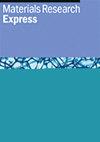基于傅立叶变换红外辐射和深度学习的化学处理芙蓉植物纤维定量和拉伸特性研究
IF 2.2
4区 材料科学
Q3 MATERIALS SCIENCE, MULTIDISCIPLINARY
引用次数: 0
摘要
天然纤维与纤维增强聚合物(FRP)的结合是实现可持续高性能复合材料的一条大有可为的途径。这些纤维来自植物的外皮部分,具有可再生、成本低和生态友好等显著优点。独特的机械和物理特性以及芙蓉树的广泛可用性使其成为研究的热点。本研究根据田口 L27 正交阵列,使用氢氧化钠 (NaOH)、高锰酸钾 (KMnO4) 和醋酸 (CH3COOH) 以不同的重量百分比(3、4、5 Wt%)和溶解时间(1、2、3 h)对 HRS 纤维进行化学处理。傅立叶变换红外(FT-IR)分析表明,O-H、C-H 伸展、C=O 分子、芳香环和 C-O/C-C 伸展发生了显著变化。高锰酸钾的处理浓度为 4 Wt%,溶解时间为 3 小时,结果最佳。多层感知器人工神经网络(MLP-ANN)已成功应用于利用实验数据准确预测经化学处理的 HRS 纤维的输出物理特性。进一步的单纤维拉拔测试结果表明,高锰酸钾浓度为 4 Wt%、溶解时间为 3 h 的样品具有最高的拉伸强度和模量。这项研究强调了化学处理工艺在提高 HRS 植物纤维性能方面的有效性,具有潜在的复合材料应用价值。本文章由计算机程序翻译,如有差异,请以英文原文为准。
Quantitative and deep learning based fourier transform infrared radiation and tensile characteristics study on chemically treated hibiscus rosa-sinensis plant fibers
Incorporation of natural fibers with Fiber Reinforced Polymers (FRPs) is a promising avenue for sustainable and high-performance composite materials. The fibers, derived from outer bark portion of plants, offer significant merits such as renewability, low cost, and eco-friendly. Unique mechanical and physical properties, and widespread availability of Hibiscus Rosa-sinensis have made them subject of intense research interest. The present study investigated the chemically treatment of HRS Fibers using Sodium Hydroxide (NaOH), Potassium Permanganate (KMnO4), and Acetic Acid (CH3COOH) bat varying weight percentages (3, 4, 5 Wt%) and solutionizing times (1, 2, 3 h) based on Taguchi’s L27 orthogonal array. Fourier Transform Infrared (FT-IR) analysis revealed significant changes in O–H, C–H stretching, C=O moiety, aromatic ring, and C–O/C–C stretching. Potassium Permanganate treatment at 4 Wt% and 3 h of solutionizing time has yielded the best results. Multi-Layer Perceptron Artificial Neural Network (MLP-ANN) has been successfully applied to accurately predict the output physical characteristics of chemically treated HRS fibers using experimental data. Further Single Fiber Pull-out test results in Potassium Permanganate at 4 Wt% and 3 h solutionizing time as best sample with highest Tensile Strength and Modulus. This research underscores the effectiveness of the chemical treatment process in enhancing the properties of HRS plant fibers for potential composite applications.
求助全文
通过发布文献求助,成功后即可免费获取论文全文。
去求助
来源期刊

Materials Research Express
MATERIALS SCIENCE, MULTIDISCIPLINARY-
CiteScore
4.50
自引率
4.30%
发文量
640
审稿时长
12 weeks
期刊介绍:
A broad, rapid peer-review journal publishing new experimental and theoretical research on the design, fabrication, properties and applications of all classes of materials.
 求助内容:
求助内容: 应助结果提醒方式:
应助结果提醒方式:


